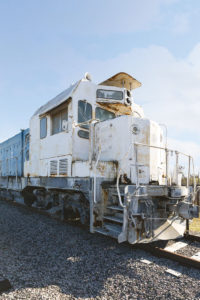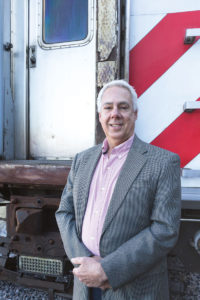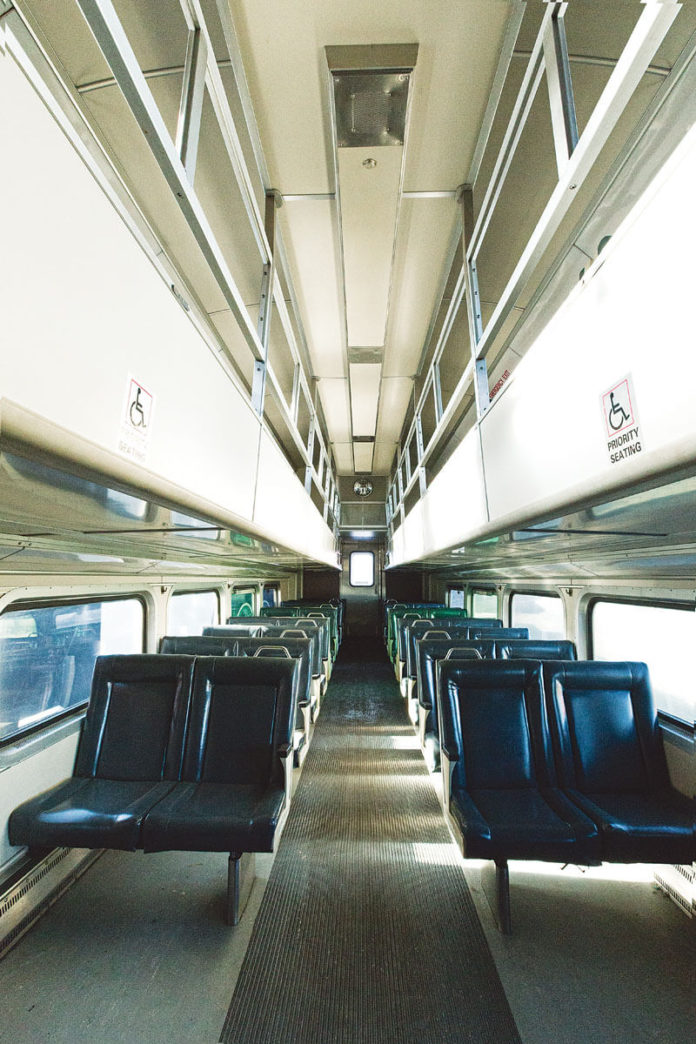My grandparents lived across the street from a railway. One of my favorite memories as a child when I visited them is sitting on their porch watching the trains roll by. My grandma and I would sit in the creaking rocking chairs sipping sweet iced tea, making up stories about the passengers and cargo aboard. Where did they come from? Where were they going and why? Little did either of us know at the time, but she was nurturing my creativity and interest in writing, encouraging me to wonder about a world that existed beyond my own backyard and introducing me to a lifelong fascination with trains.
Fast forward more years than I care to admit, and I still love trains. There is something special about the rhythmic sound of the wheels clicking and clacking down the track and the deafening sound of the horn when the conductor announces the train’s presence at a crossing or intersection. The gentle motion of the cars as they amble through the countryside is comforting and allows for a great view of the landscape you are exploring, or the train may be delivering goods supporting economic growth.
 When I heard about Frisco’s Museum of the American Railroad, I knew I had to check it out. The railroad is so significant to North Texas culture and history. The museum showcases artifacts and archival material from the railroad industry to exhibit and interpret their significance in American life and our country’s growth and culture. And, an opportunity to climb aboard historic trains … count me in!
When I heard about Frisco’s Museum of the American Railroad, I knew I had to check it out. The railroad is so significant to North Texas culture and history. The museum showcases artifacts and archival material from the railroad industry to exhibit and interpret their significance in American life and our country’s growth and culture. And, an opportunity to climb aboard historic trains … count me in!
The museum’s humble beginnings originated in Dallas’s historic Fair Park. Founded in 1962, the Museum of the American Railroad is dedicated to celebrating the heritage and exploring the future of railroads through historic preservation, research and educational programming. CEO Bob LaPrelle says, “In the strategic planning process in the summer of 2006, one thing became very clear, and that was that we were out of space. Secondly, our collection was overdue to be covered by a structure that would protect it from the elements. There were several other basic needs to be addressed in the planning process such as our desire to keep the present collection intact and to build a new facility that would be flexible and allow for the activities associated with a modern museum, particularly increasingly popular after-hours programs. We clearly needed to relocate.”
 Enter the city of Frisco. Mr. LaPrelle shares, “The City of Frisco was experiencing phenomenal growth and was looking for opportunities to add new attractions to the community and still preserve its small-town heritage. The City of Frisco is named after the St. Louis San Francisco Railroad, nicknamed “Frisco.” Thus began talks for the museum to make its move to Frisco. Discussions between our museum and the city continued for several months, with each meeting revealing the mutual benefits of relocating our collection to this vibrant North Texas community.”
Enter the city of Frisco. Mr. LaPrelle shares, “The City of Frisco was experiencing phenomenal growth and was looking for opportunities to add new attractions to the community and still preserve its small-town heritage. The City of Frisco is named after the St. Louis San Francisco Railroad, nicknamed “Frisco.” Thus began talks for the museum to make its move to Frisco. Discussions between our museum and the city continued for several months, with each meeting revealing the mutual benefits of relocating our collection to this vibrant North Texas community.”
The actual move to Frisco spanned several months and involved house movers for historic structures and several rail lines for equipment moves. Today, the Frisco Heritage Museum, which opened its doors on May 3, 2008, is part of a planned Heritage Center complex that features historic homes and other structures from around Collin County. Right now, exhibit tracks 6, 7, and 8 are completed (as of September 2016) and bear vintage rail pieces and equipment. The museum is still fundraising to begin construction on the remaining exhibit tracks and site amenities. Phase II of construction will allow for the development of more exhibit tracks, placement of even more pieces of vintage rolling stock and basic visitor amenities such as sidewalks and lighting.
North Texas’ past is rich in railroad history. Mr. LaPrelle explains, “The museum’s programming works to introduce guests and students to the history of the railroad and its impact on technology and culture, but we also work to introduce our audiences to the cutting-edge technologies created by the railroad industry. Additionally, we introduce students to high-tech jobs in the rail industry and in the field of logistics.”
The walking tours meet up outside the Frisco Discovery Center. The guides are very knowledgeable, personable and eager to share their passion about the history of the railroad. They thankfully keep the groups small, so each visitor receives a personal, informative experience.
Mr. LaPrelle shares, “The current guided walking tour of the museum’s equipment includes photo ops with the world’s largest steam locomotive (almost half of a football field long) and the Union Pacific ‘Big Boy’ #4018 weighs in at an impressive 1.2 million pounds!”
Guests also tour heavyweight cars such as the first Pullman car “Glen Nevis.” According to the tour guide, Mr. Bob Palka, these passenger fleets were the first-class answer to the passengers who wanted to explore the country. This 1800s vintage rail car is impressive and impeccably preserved. Definitely the way to travel! They even have the car that Harry Truman used for his presidential campaign.
Mr. LaPrelle further explains, “Guides also interject rail history, personal accounts and stories of folks who worked at the railroad. The museum also has indoor exhibits on the second floor of the Frisco Heritage Museum. Special exhibit panels created by the museum’s staff feature the story of the railroad’s role in North Texas, and in Frisco, particularly. The exhibit features a railroad handcar, a wig-wag crossing signal, dining car china, items from the Pullman Company and various graphics.”
The museum currently has more than 40 pieces of rolling stock equipment, which include steam locomotives, diesel locomotives, an electric locomotive, passenger cars, dining cars and freight cars. The collection also includes two historic structures, Santa Fe Interlocking Tower 19 and a circa-1900 Houston and Central depot. Mr. LaPrelle adds, “We recently acquired 10 commuter cars from Metra in Chicago. We plan to use several of these cars as classrooms for immersion educational programming. Additionally, the museum’s 1937 Missouri-Kansas-Texas dining car is still used for small special events onsite. We have hosted several small luncheons and fundraisers in the 36-seat space. The dining car has been restored to its original 1937 configuration.”
A few months ago, the museum received a call from Beverly Miles of Como, Miss. She wanted to donate several important railroad related items from her family. Her grandfather, John Lee Nolen, had worked in Memphis, Tenn., as a fireman and an engineer for the Frisco Railroad. He fought overseas during World War I and began his railroad career after that. Among the items donated were Mr. Nolen’s pocket watch, his 25-year service pin from the Brotherhood of Locomotive Engineers and photographs. These newly-acquired pieces help reveal more interesting history of the railroad in America.
The museum is also home to a caboose built in 1927 once owned by Don Carter, founding owner of the Dallas Mavericks. He turned it into a playhouse for his children and grandchildren. Historically, the caboose was an important part of the train because the caboose engineer could keep an eye on the front of the train as it rounded curves. Personally, I loved waiting for the caboose because the man aboard at the end of the train always gave a hearty wave in response to mine. He probably waved to hundreds of kids a day, but he made me feel special.
The museum collects artifacts and archival material from the railroad industry to exhibit and interpret their significance in American life and culture, and they have some of the coolest trains on display, ever! Mr. LaPrelle concludes, “We are very happy to serve the community of Frisco and broader North Texas communities through our programming, special events and retail presence. We look forward to our growth in Frisco and further expanding programming and events at our new site.”
Staying true to its roots, the Museum of the American Railroad in Frisco continues to offer exhibits, tours and general programs year-round. Educational programs are available to local schools and universities through study trips, in-class programming and outreach and online resources. The public is welcome to explore the trains and visitor’s center during scheduled hours. Visit the museum website at museumoftheamericanrailroad.org for more information about the museum’s growth and expansion or to schedule a tour.


